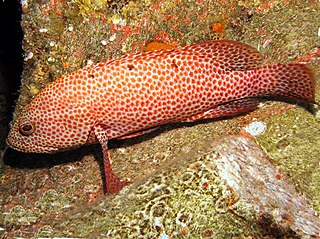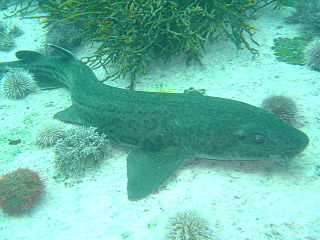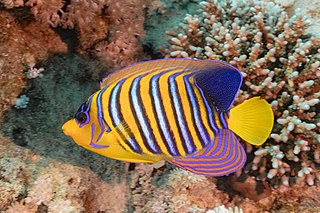
Anomalopidae are a family of fish distinguished by bioluminescent organs located underneath their eyes, for which they are named. These light organs contain luminous bacteria and can be "shut off" by the fish using either a dark lid or by being drawn into a pouch. They are used to communicate, attract prey, and evade predators.

The Beryciformes are a poorly-understood order of carnivorous ray-finned fishes consisting of 7 families, 30 genera, and 161 species. They feed on small fish and invertebrates. Beyond this, little is known about the biology of most member species because of their nocturnal habits and deepwater habitats. All beryciform species are marine and most live in tropical to temperate, deepwater environments. Most live on the continental shelf and continental slope, with some species being found as deep as 2,000 m (6,600 ft). Some species move closer to the surface at night, while others live entirely in shallow water and are nocturnal, hiding in rock crevices and caves during the day. Several species are mesopelagic and bathypelagic. Beryciformes' bodies are deep and mildly compressed, typically with large eyes that help them see in darker waters. Colors range from red to yellow and brown to black, and sizes range from 8–61 cm (3.1–24.0 in). Member genera include the alfonsinos, squirrelfishes, flashlight fishes, fangtooth fishes, spinyfins, pineconefishes, redfishes, roughies, and slimeheads. A number of member species are caught commercially, including the alfonsino, the splendid alfonsino, and the orange roughy, the latter being much more economically important. Some species have bioluminescent bacteria contained in pockets of skin or in light organs near the eyes, including the anomalopids and monocentrids.

Holocentridae is a family of ray-finned fish, the only family of the order Holocentriformes. The members of the subfamily Holocentrinae are typically known as squirrelfish, while the members of Myripristinae typically are known as soldierfish. In Hawaii, they are known by the Japanese name mempachi/menpachi (メンパチ) or the Hawaiian ʻūʻū.

The graysby is a species of marine ray-finned fish, a grouper from the subfamily Epinephelinae which is in the family Serranidae which also includes the anthias and sea basses. It is found in the western Atlantic. It is associated with reefs and is a quarry species for commercial and recreational fisheries.

The lane snapper, the Mexican snapper, redtail snapper or spot snapper, is a species of marine ray-finned fish, a snapper belonging to the family Lutjanidae. It is native to the western Atlantic Ocean.

The leopard catshark is a species of catshark, and part of the family Scyliorhinidae, endemic to the coastal waters of South Africa. Abundant in inshore waters under 20 m (66 ft) deep, this bottom-dweller favors rocky reefs, kelp beds, and sandy flats. Growing to a length of 84 cm (33 in), the leopard catshark has a stout body with two dorsal fins placed well back, and a short head and tail. It is extremely variable in color and pattern, with individuals ranging from almost white to black and covered by diverse patterns of black spots, blotches, rosettes, and/or lines. The color pattern changes with age and some forms seem to be location-specific, suggesting the presence of multiple distinct, local populations. In the past, some of the more distinct color forms have been described as different species.

The royal angelfish, or regal angelfish, is a species of marine ray-finned fish, a marine angelfish belonging to the family Pomacanthidae, and the monotypic genus Pygoplites. It is found in tropical Indo-Pacific oceans. It can grow as long as 25 cm.

The Hong Kong grouper is a species of marine ray-finned fish, a grouper from the subfamily Epinephelinae which is part of the family Serranidae, which also includes the anthias and sea basses. It is found in eastern and southeastern Asian waters of the Western Pacific Ocean. Its natural habitats are shallow seas and coral reefs.

The camouflage grouper, also known as the blue-tailed cod, camouflage rockcod, small-toothed rockcod, smooth flowery rock-cod, snout-spot grouper or snout-spot rock-cod, is a species of marine ray-finned fish, a grouper from the subfamily Epinephelinae which is part of the family Serranidae, which also includes the anthias and sea basses. It has a wide Indo-Pacific distribution where it is associated with reefs.

Serranus tigrinus, the harlequin bass, is a species of marine ray-finned fish, a sea bass from the subfamily Serraninae, which is a part of the family Serranidae, which also includes the groupers and the anthias. It can be found in the western Atlantic Ocean, and also in aquarium trades.

Plectropomus laevis, known commonly as the black-saddled coral grouper, cluespotted coral trout, blacksaddled coral trout, blue-spot trout, Chinese footballer, footballer cod, footballer coral trout, oceanic coral trout or tiger trout, is a species of marine ray-finned fish, a grouper from the subfamily Epinephelinae which is part of the family Serranidae, which also includes the anthias and sea basses. It is found in the Indo-Pacific region.

The sixbar wrasse or six-banded wrasse is a species of wrasse in the family Labridae, native to the Indian Ocean and the western Pacific Ocean. It is an inhabitant of reef environments at depths from the surface down to 15 m (50 ft). This species can grow to 20 cm (8 in) in total length, though most individuals do not exceed 15 cm (6 in). It is of minor importance to local commercial fisheries and can also be found in the aquarium trade.

The splitfin flashlightfish or two-fin flashlightfish is a species of beryciform fish in the family Anomalopidae. It is found in warm waters in the central and western Pacific Ocean near shallow reefs 200–400 m (660–1,300 ft) in depth. It can grow to a length of 35 cm (14 in) TL. It is the only known member of its genus.
The Atlantic flashlightfish is a species of flashlight fish native to the western Atlantic Ocean. During the day, it is found in waters as deep as 200 metres (660 ft). On moonless nights, it ascends to shallow waters around 25 metres (82 ft) in depth where it feeds on small shrimp and copepods as it swims over the ocean floor. This species grows to a length of 12.5 centimetres (4.9 in) TL. This species is the only known member of its genus and can be found in the aquarium trade.
Photoblepharon is a genus of poorly understood flashlight fishes found around reefs in the western Pacific Ocean (P. palpebratum) and in the western Indian Ocean (P. steinitzi). Both of its species are nocturnal predators, hiding in caves and crevices during the day and emerging at night to feed. They are small fish, 11.0–12.0 cm (4.3–4.7 in) maximum length, and of little commercial value, although fishermen have been known to use their light organs as bait. Like other anomalopids, they are notable for the white organs containing bioluminescent bacteria underneath their eyes, which, by emitting a blue-green light, allow the fish to search for food, evade predators, and communicate with other fish. Both species have black lids that slide up to cover the organ when the fish does not want to emit light. Although similar in appearance, they can be easily distinguished by the preopercle, which has a medium-sized white spot in P. palpebratum, whereas in P. steinitzi, it is much smaller and much darker, or not present at all. Neither species has been evaluated by the International Union for Conservation of Nature (IUCN) and their nocturnal natures make collection difficult and sightings uncommon.
The Gulf flashlightfish is a species of saltwater fish of the family Anomalopidae, also known as lanterneye fish, of the order Beryciformes. It is endemic to the Gulf of California. This cryptic fish is the only known member of its genus. It was first reported in the Pacific Ocean in 1976 and is extremely rare.
Flashlight fish is a common name for several fish and may refer to:
Parmops coruscans is a species of flashlight fish, order Beryciformes, native to the Pacific Ocean off the coast of Tahiti and from Fiji to French Polynesia. It is one of two species of Parmops along with P. echinatus, which was discovered off the coast of Fiji. Like other anomalopids, it is notable for the light organs underneath its eyes, which contain bioluminescent bacteria. To cover the organs, it rotates them down while sliding a black lid upward over each eye. The lack of development in its shutter mechanism helps place it between Anomalops and Phthanophaneron on the evolutionary tree.
The flashlight fish is a species of anomalopid fish of the order Beryciformes. It is native to the western Indian Ocean and the Red Sea where it is found near coral reefs. It is a nocturnal predator, hiding in crevices and caves by day and emerging to feed at night. At 11.0 cm (4.3 in) in length, it is small and relatively stout. Its body is mostly solid black, with the exception of white discoloration around its pectoral fins and a lateral line of reflective scales. It is most notable for the bioluminescent organs located underneath its eyes, which it uses to find prey, evade predators, and communicate with other members of its species. Like other Beryciformes, its reproduction is oviparous. It has no commercial value, and this combined with its timid, nocturnal nature makes population sizes and trends unknown. It is listed as Least Concern by the International Union for Conservation of Nature (IUCN) due to a wide distribution and lack of known threats.
Protoblepharon rosenblatti, the Cook Islands flashlightfish, is a species of flashlight fish found in the waters surrounding the Cook Islands. It can reach lengths of up to 22.0 cm (9 in) and can be found as deep as 274 m (900 ft).













